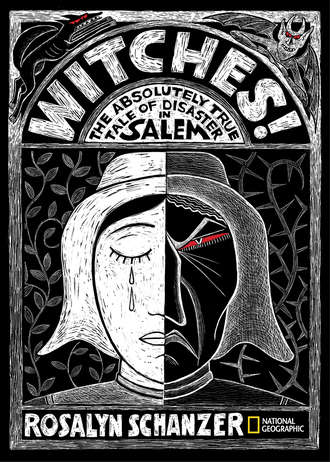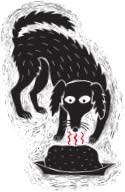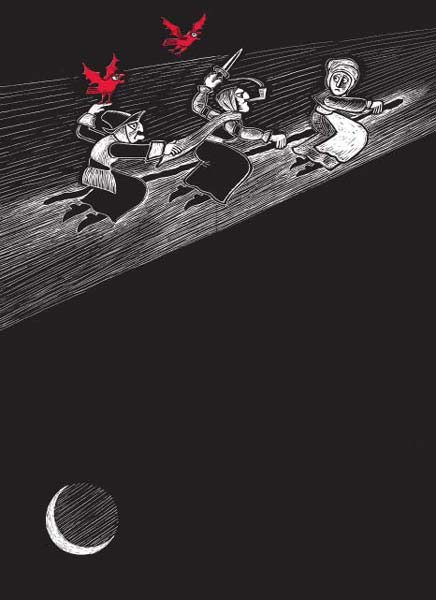
Полная версия
Witches: The Absolutely True Tale of Disaster in Salem
The rash of mysterious fits never disappeared completely, and by the 1680s, rumors about this dread disease were scaring people half to death. Fear spread even farther when a popular father-and-son team of Boston ministers named Increase and Cotton Mather wrote several astonishing books and essays about settlers who were possessed by demons or plagued by witches. One of the most terrifying tales came from Cotton Mather’s 1689 best seller, Memorable Providences. Everyone flocked in droves to read this story, especially since Mather claimed that he had watched with his own two eyes as every detail unfolded.
In the reverend’s book, four children from a pious Boston family were suffering from horrible fits. Their tongues would first be sucked down their own throats, then pulled out upon their chins to a prodigious length. Their jaws would snap out of joint and then clap together like a strong spring lock. They cried that they were being cut with knives, then struck with blows. Their necks were broken! Their heads were twisted almost all the way around! And they would bark like dogs or roar exceedingly loud. These tortures were blamed upon a neighbor, an old Irish Catholic washerwoman named Goody Glover, who was suspected of being a witch. Before long, she was tried in court and hanged by the neck until dead. Surely Reverend Parris and Dr. Griggs knew all about this famous tale.
The day after Dr. Griggs presented his dire diagnosis to the Parris family, Reverend and Mrs. Parris rode off to a lecture. While they were there, they hoped to invite some neighboring ministers to join them in their home for a solemn day of prayer. But as soon as the parents left, the two Parris slaves, Tituba and John Indian, did something that was strictly forbidden. They knew that in New England, people used folk magic all the time to perform cures, even though Puritan ministers railed against it. There were ways to draw out witches—by boiling snippets of children’s hair, for example—and the two slaves were apparently so worried about Betty and Abigail that John Indian accepted a set of instructions from their helpful neighbor, Goodwife Mary Sibley, telling how to bake a black magic witchcake.
Carefully following Sibley’s recipe, Tituba and John Indian mixed some rye flour with the afflicted girls’ urine, patted it into the shape of a cake, and baked it in the ashes of their fireplace. The trick was to feed this magical witchcake to a dog. Ancient European folklore alleged that dogs were the “familiars” of witches. This meant that dogs were actually imps disguised as animals to help witches do their dirty work. When a dog ate a witchcake, the witches’ spells were supposed to be broken. Then the victims could reveal the witches’ names for all to hear.

But when Reverend Parris and his wife got home and found out about the witchcake, they were absolutely furious. Using black magic was an enormous sin! Though the two slaves were probably just trying to help, black magic could not be tolerated. Parris would later preach that Goodwife Sibley had “a-going to the Devil for help against the Devil.”
Betty and Abigail must have been terrified by now; their fits and strange gibbering grew worse, and the contortions of their backs, necks, and arms were frightful to behold. Maybe Parris and his family still had not been pious enough! Parris and the neighboring ministers prayed together. He and his family fasted yet again. And he made sure that everyone in his household doubled their prayers again, too. But the minute a prayer would end, the girls’ fits began anew.
So Parris, the other ministers, and certain townsfolk pressed Betty and Abigail hard to reveal the witches’ names. Whose evil spirits had ventured forth from the Invisible World to torture them? How could the girls ever get well if the guilty witches were allowed to roam free?
If these two impressionable children were convinced that witches were out to get them, whom should they blame? Maybe their tormentors were the usual suspects, people their family didn’t like or respect. Tituba seemed to be a logical choice. Besides making the witchcake, she was a slave, and an Indian slave at that.
After all, everybody the girls knew was convinced that Indians were in league with the Devil. So Betty and Abigail declared that Tituba was a witch and that Tituba’s spirit, which was invisible to everybody else but themselves, had been pinching them and pricking them and chasing them around the room.
Before long, they claimed that two other women’s spirits had tortured them as well.
First, Betty and Abigail remembered Sarah Good, the muttering beggar woman who had pled for food for her two young children. In Salem Village, nobody liked a beggar, especially an ungrateful, pipe-smoking beggar. She had to be a witch.
And then they pointed the finger at a bedridden old farm woman named Sarah Osborn, whose young second husband used to be her own servant. She had not gone to church for more than a year, and rumor had it that this husband was a wife-beater. Nobody liked Osborn either, especially a certain family called the Putnams, who had fought with her for years over some land and were now leading members of Parris’s church. Betty and Abigail claimed they had seen a bird with a human head that turned into Sarah Osborn! She was obviously a despicable witch.
Tituba said she loved Betty and would never have hurt her, but Reverend Parris seemed not to believe a word she said. It was time to take action. So on February 29, 1692, the first official complaints were filed by two Salem Town magistrates, and the three accused witches were arrested.
Word traveled fast. Even as the arrests were taking place, more people began to say they were tormented by fits. And almost every one of them would claim that it was witches—or the witches’ spirits—that were torturing them.
The first of these new accusers was a clever 12-year-old girlfriend of Betty and Abigail named Ann Putnam Jr. Ann’s parents were the very strongest supporters Reverend Parris had in Salem Village. It seems that Ann was having dreadful fits, and they were all because the spirit of that beggar woman named Sarah Good was pinching her and trying to make her sign the Devil’s evil book.
Then a 17-year-old girl named Elizabeth Hubbard claimed she had been chased by a wolf that turned into Sarah Good and attacked by the bedridden old lady, Sarah Osborn. Hubbard happened to be the niece of Dr. Griggs, the very same physician who had first blamed Betty’s and Abigail’s fits on witchcraft. Not only did Hubbard live in Dr. Griggs’s house, but she was friends with Betty and Abigail, too.

CHAPTER THREE
LET THE GRILLING BEGIN

On March 1, hordes of gawkers from miles around rode on horseback or slogged on foot through the flooded coastal roads leading to a tavern in Salem Village. They could hardly wait to find out what would happen at the questioning of the three suspects. Before long, an ugly crowd grew so big that everyone had to move to the church instead.
Today’s plan was to question the suspects and decide if they should appear before a grand jury at a later date. If the grand jury determined that there was enough evidence against these three women, they would eventually face a formal trial.
Nobody could be executed for witchcraft (or anything else) before appearing all three times. But accused people could most certainly be sent to prison. In fact, they would be stuck in the jailhouse for a very long time as the process dragged on.
First, the three accused women were examined for witch’s marks; did they have warts or bumps anywhere on their bodies that could be used as teats to feed their evil animal familiars? Not a mark was found.
Next, the two magistrates began their interrogation. Only one suspect was brought into the room at a time, but even before the defendants spoke a single word, it was obvious that the magistrates thought all three of them were witches. And it didn’t help their cause a bit when all day long the four accusers kept screeching and tumbling around on the floor and crying out that the suspects’ spirits were swooping through the air to torture them.
A man named Ezekiel Cheevers wrote down the questions and answers as fast as he could. Of course he already thought the women were guilty, too, as you can tell from his comments.
THE EXAMINATION OF SARAH GOOD A
Magistrate John Hathorn (H): Sarah Good, what evil spirit is your familiar?
Sarah Good (G): None!
H: Why do you hurt these poor children?
G: I do not hurt them. I scorn the very idea.
H: Then what creature do you employ to hurt them?
G: There is no creature. I am falsely accused!
H: Why did you go away muttering from Mr. Parris’s house?
G: I did not mutter. I thanked him for what he gave my child.
Recorder’s note: Hathorn asked the children to look upon Sarah Good and see if this were the person who had hurt them, and so they said this was one of the persons that did torment them. Presently they were all tormented by fits.
H: Sarah Good, do you not see what you have done? Why don’t you tell us the truth? Who do you serve?
G: I serve God. The same God that made heaven and earth!
Recorder’s note: Her answers were given in a very wicked, spiteful manner, retorting against the authority with foul and abusive words and many lies. Her husband said that he was afraid she either was a witch or would become one very quickly. “And indeed,” said he, “I may say with tears that she is an enemy to all that is good.”
THE EXAMINATION OF SARAH OSBORN
The girls in the courtroom announced that Sarah Osborn was one of the three witches who were torturing them in this very room. Then they began to shake violently and tumbled to the floor.
When grilled by the furious magistrate, Osborn cried that she had never seen an evil spirit or met with the Devil in her life. She was not tormenting anyone!
“Sarah Good sayeth it was you that hurt the children,” argued the magistrate.
“I have not seen her for two years,” Osborn replied, insisting that for all she knew, the Devil had the power to make himself look exactly like her. Then he could go around in her shape to attack the girls, but she would have to take the blame.
Three people reported that the bedridden woman thought she was more likely to be the victim of witchcraft than to be a witch herself. When asked to explain, Osborn replied that she had dreamed she saw a black Indian who pinched her and pulled her to the door. Hathorn was not impressed. Implying that she was unfaithful to God, he asked why Osborn hadn’t come to church for the past two years. “Alas! I have been sick and not able to go,” she cried.
THE EXAMINATION OF TITUBA
The afflicted girls again began to writhe around, screech, and howl when the slave Tituba’s turn came to be questioned. At first she said she was completely innocent and that she and the children would never hurt each other. But a little later, she completely changed her tune and confessed that she was guilty!
The recorder who wrote down everyone’s testimony didn’t bother to say so, but it’s possible that the questioning stopped for a while and then started up again after a break, because many months later Tituba would reveal that she had lied when she told the court she was a witch. She claimed Reverend Parris had beaten her to make her confess and to make sure that she accused the two women Parris called her “sister-witches.” He even threatened not to pay any of the fees required to get her out of jail unless she told the magistrates that she was guilty. Tituba must have followed her master’s orders:
Magistrate (M): What doth the Devil look like?
Tituba (T): Like a man. Yesterday he told me to serve him & I told him no, I would not do such a thing.
Tituba charged that Sarah Osborn and Sarah Good were torturing the children and wanted her to hurt them, too. And she said she had seen two more witches from Boston just last night when she was cleaning. They told her she had to hurt the children, and if she refused they would hurt her themselves. At first she agreed to hurt Betty and Abigail, but afterward she was very sorry and told the women she wouldn’t do it any more.
T: The creature that looked like a man came to me just as I was going to sleep. He said he would kill the children and they would never get well if I would not serve him.
M: What other creatures hath appeared to you?
T: Sometimes a hog. Four times a great black dog who told me to serve him. I told him I was afraid, then he told me he would do worse tortures unto me.
Tituba said that the man had pretty things and offered her a little yellow bird if she would become his servant. Then he sent her two cats: one red and one black and as big as a dog. But when she said her prayers and tried not to pinch Betty and Abigail, the cats scratched at her eyes, pulled her across the room, and almost threw her into the fire. Tituba felt even worse when the man appeared with Dr. Griggs’s niece and made her pinch this girl, too.
M: Did you ever go along with these women Sarah Good and Sarah Osborn?
T: Yes, they are very strong & pulled me & made me go with them up to Mr. Putnam’s house to hurt his Child. The man pulled me, too. But I am sorry.
M: How did you get there?
T: We Rode upon a stick with Good & Osborn sitting behind me & taking hold of one another. I Saw no trees nor path, but was presently there. They Told me I must kill Thomas Putnam’s Child with the knife.
Ann Putnam Jr. confirmed Tituba’s story, saying that they would have made Tituba cut off her own head if the slave refused to kill her.
Then, said Tituba, Good had tried to give her the yellow bird or a cat. Tituba refused to take them, though she wished she could give the pretty bird to the children.
M: What did Osborn have?
T: She hath two creatures. One hath wings & two Legs & a head like a woman’s. The other thing was all over hairy, all the face was hairy & had a long nose & I don’t know what it is. It was about two or three feet high & walked upright like a man, and at night it stood before the fire in Mr. Parris’s hall.
Конец ознакомительного фрагмента.
Текст предоставлен ООО «ЛитРес».
Прочитайте эту книгу целиком, купив полную легальную версию на ЛитРес.
Безопасно оплатить книгу можно банковской картой Visa, MasterCard, Maestro, со счета мобильного телефона, с платежного терминала, в салоне МТС или Связной, через PayPal, WebMoney, Яндекс.Деньги, QIWI Кошелек, бонусными картами или другим удобным Вам способом.



